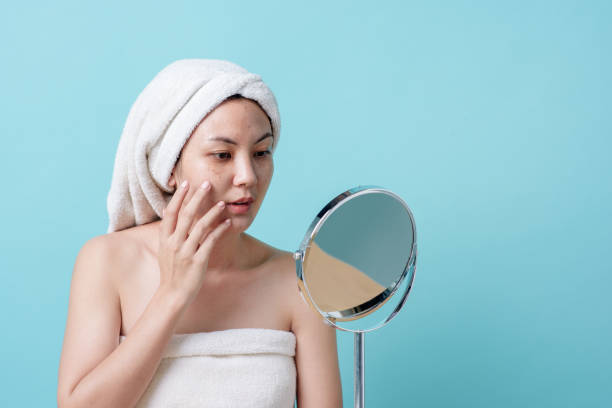The mask of pregnancy: What mums-to-be need to know about chloasma

As an expectant mum's body makes room for her growing baby, she will experience various physical changes, one of the most common being skin problems, like hyperpigmentation. Learn about chloasma, or melasma in pregnancy here.
Hyperpigmentation causes skin darkening due to an increase in melanin production. Melanin is responsible for the colour of our skin.
Melasma, which is also referred to as chloasma, is a type of hyperpigmentation. Also known as the "mask of pregnancy," melasma often appears as brown, tan, or blue-grey patches on the face, particularly around the nose, cheekbones, and jaw.
Melasma is a skin condition in which your skin's melanocytes (pigment-producing cells) create excessive pigment for unknown reasons. It's known as chloasma, or the "mask of pregnancy", throughout pregnancy.
Chloasma is a skin condition. It has no effect on your baby and does not signal any other pregnancy issues.
The cheekbones, nose, chin, area above the top lip, and forehead are where melasma most frequently develops. Your arms, neck, and back can occasionally be affected. Melasma can, in fact, affect any area of your skin that is exposed to sunshine. The majority of melasma sufferers observe that their symptoms worsen in the summer, which explains why.
During pregnancy, the steep escalation of oestrogen (primary female sex hormone) causes an increase in pigmentation on the face — thus why the condition is commonly referred to as the mask of pregnancy.
There are three types of melasma:

Senior Dermatologist and previous Deputy Medical Director at the National Skin Centre, Dr Tham, Tham Siew Nee Skin Clinic (Gleneagles Hospital), explains how the rise in oestrogen during pregnancy triggers excess melanin (responsible for skin and hair colour) production.
This explains the darkening of the skin. Apart from the face, melasma also affects other areas of the skin such as the nipples, areola and vulva. Your existing moles and freckles may darken and there is likely to be a dark line down the centre of your abdomen (linea nigra).
As in the case of many medical conditions, it is difficult to pinpoint the exact cause of melasma. There are however a number of factors that increase the likeliness of it occurring.
Dr Tham states that melasma can just about affect anyone, but the following groups of people face higher risks:
In her practice, Dr Tham notes that melasma is a common condition in Singapore and that all racial groups seem to have equal chances of developing it. She emphasised that melasma is definitely more common among those who are constantly outdoors.
So mums-to-be, it might be a good idea to give the tanning a break and head indoors instead!

Chloasma is common and there is nothing about it that is serious enough to cause you to be a bundle of nerves or make your blood run cold. The hyperpigmentation usually disappears after delivery or at times, when you stop breastfeeding. It is an aesthetic problem more than anything else.
As melasma is not exclusive to pregnancy, there are chances that it may reappear later in life. It is generally caused by hormonal changes and as such, throughout your reproductive age, you remain susceptible to the condition.
Dr Tham describes melasma to be an asymptomatic (a disease or infection with no symptoms) condition. It is mainly a cosmetic problem appearing as irregular pigmentation mostly on the cheeks, nose and forehead.
Patches of discolouration, darker than your normal skin colour tend to appear on your face in a symmetrical manner.
Melasma causes coloured patches to appear on your cheeks, chin, forehead, the bridge of your nose and at times even your upper lip. Other areas of your skin such as your neck and forearms, which are in more contact with sunlight may also face discolouration.
Melasma typically presents itself as freckle-like spots or larger, flat and brown patches. It appears symmetrically on both sides of your face with an irregular border. At times you may also encounter reddened or inflamed forms of melasma.
Meanwhile, here are five common symptoms associated with melasma in pregnancy:
The hallmark symptom of chloasma is the presence of hyperpigmented patches on the face. These patches are typically brown or greyish-brown in colour and appear symmetrically on the cheeks, forehead, nose, and upper lip.
Chloasma often takes on a mask-like appearance, hence its name. The patches may resemble a butterfly shape across the cheeks and nose or appear as larger areas of pigmentation on the forehead.
Sunlight can exacerbate chloasma, causing the patches to darken further. The affected areas may become more pronounced and visibly darker after sun exposure.
Chloasma is typically a cosmetic concern and does not cause any associated itching, pain, or discomfort. The patches are primarily a result of increased pigmentation and do not involve inflammation or other physical symptoms.
In cases of chloasma during pregnancy or hormone use, the condition may gradually fade and improve after childbirth or discontinuation of hormonal treatments. However, it's important to note that complete resolution may take time, and some individuals may require further treatment or management.

According to Healthline, although melasma can start at any stage during pregnancy, it often does so in the second or third trimester.
Once more, there are many variables at play as pigment darkens. Depending on your skin type and tone, this issue may be more or less evident. When you first notice it may also depend on how much time you spend outside in the sun or even the season when you're pregnant.
Melasma is not a very complicated condition and its appearance is highly characteristic. A simple visual examination is usually sufficient for diagnosis.
At times, your doctor might advise you to undergo other tests to rule out certain conditions or specific causes. In rare situations, a skin biopsy (sample skin tissue taken for close examination) may be ordered to confirm the diagnosis of melasma and rule out serious skin conditions.
One of the testing methods that may be used is known as the Wood's lamp examination. This involves holding a special kind of light up to your skin. This examination aids in determining if there is any infection present and the type of melasma (how many layers of skin are affected) that has affected you.
Dr Tham wishes for you to know that although melasma is generally harmless, it is necessary to get the diagnosis confirmed by an experienced doctor as some conditions like drug-induced pigmentation or contact dermatitis may appear similar.
While melasma treatment options are aplenty, many treatments are not safe during pregnancy or while breastfeeding. Azelaic acid, a topical cream and a glycolic acid chemical peel are considered safe but it is a must to consult your doctor before using any of these.
It is unpleasant to have blotchy skin and it is only natural to want to do something about it at soonest, but it is very important not to do anything that is unsafe for you or your baby during this crucial period. Peels, bleach and other lightening treatments should not be used during pregnancy for they may penetrate your skin.
Don't even think about laser treatments as a melasma treatment option!
Administrative manager Mdm Fauziah developed melasma during her first pregnancy. She shares her experience:
"I have always been very conscious about the way I look and so pregnancy, and the changes it brought, put me on an emotional roller-coaster. First it was the weight gain, then the puffiness, then the skin patches (melasma), the line down my belly and whatnot.
Initially, I became self-conscious and even depressed whenever I saw a change and when my face started having these pigmentation problems, it was like the icing on the cake. I was so upset and wanted to do whatever I could to get rid of it. Then when I consulted my doctor and read up about how some treatments might be unsafe, I snapped out of it.
Suddenly I felt quite ashamed of myself. I realised that all these things that were changing in my body were a small price to pay for a bigger blessing. My husband also comforted me by reminding me that these changes are not permanent."
So remember ladies, if you feel self-conscious or that your confidence is shaken, you are definitely not alone. Hang in there and you can seek treatment options when the time is right!

The good news is that this hyperpigmentation is unlikely to worsen after your baby is born. However, without any focused treatment, it may take a long time, possibly months, to totally diminish.
Many people find that their dark spots due to melasma improve once they're no longer pregnant, when their hormonal levels return to their pre-pregnancy levels. Keep in mind, though, that once you've had this patchwork pigmentation, you're more likely to get it again if you get pregnant in the future.
Chloasma usually disappears after birth or when you stop breastfeeding. Once the hormones return to its original hormonal balance, dark spots will fade away.
Thankfully, it simply affects your skin's appearance, and it's not the type of skin disorder that causes cancer or can lead to cancer. However, because there are skin malignancies that resemble melasma, it's critical to contact your dermatologist for a proper diagnosis.
Consult your doctor for advice on how to manage your chloasma. For more information, your doctor could suggest that you consult a dermatologist.
Some medical professionals advise against treating melasma when pregnant. One explanation is that it might get better on its own. Additionally, using some treatments while pregnant may not be safe or effective.
With the aid of a few lifestyle modifications, prevention might potentially be the greatest form of treatment.
This does not, however, imply that you must remain indoors when the sun is shining. It's beneficial to use a good pregnancy-safe sunscreen with an SPF of 30 or higher.
Rather than chemical blockers, look for sunscreens that contain zinc oxide, titanium dioxide, or other physical blockers (mineral sunscreens). Physically applying sunscreens provides more coverage and may be less irritating to the skin.
Clothing with or without UV protection, such as SPF rash guards or sun-protective clothing, is another alternative for sun protection. Loose-fitting clothing, even if it's warm outside, can keep you cool and protect your skin.
How about the face? Hats with a wide brim are your best friend. Don't forget to wear a trendy pair of sunglasses, the larger the better.
Irritating face cleansers, lotions, and serums may aggravate your melasma. Instead, slather on some soft products. If you're overwhelmed in the beauty aisle, look for words like "non-comedogenic," "sensitive," "fragrance-free," or "dermatologist approved" on the label.
The same can be said for whatever cosmetics you could use to cover up the dark spots. Look for foundations, concealers, powders, and other cosmetics that are non-comedogenic or hypoallergenic.

Now, you may be wondering how to treat melasma during pregnancy. Here are some ways or some melasma treatment in pregnancy that you may try:
If chloasma doesn't disappear after giving birth, talk to your dermatologist about other options. Since it may take months before the discolouration completely fades, many women are prescribed topical medications, like hydroquinone, tretinoin, and corticosteroids.
Certain acids that lighten the skin, either alone or in combination, may be recommended by your doctor but take note that it can only be treated after childbirth.
There are also home remedies that are effective in treating melasma. If you prefer to treat melasma the natural way, here are some home remedies to try: lemon juice, apple cider, milk of magnesia, oatmeal and honey.
Combine half fresh lemon juice and half cucumber juice (or water) in a solution. The acid in the juice may aid in the removal of pigmentation in the skin's top layer.
To use as a toner on dark areas, make a solution with half ACV and half water.
After washing your face, use a cotton ball to apply milk of magnesia to dark areas. Allow to sit on the skin overnight and then wash off the next morning.
Make a mask with raw honey and baked oats (let it cool so it's not too hot). Allow 10 minutes for the product to absorb into the skin before rinsing. The honey enzymes help to exfoliate your skin, and the mask may brighten it slightly.
If none of these treatments work, dermatologists usually recommend a chemical peel, microdermabrasion, or dermabrasion treatment.
TCM generally uses manual acupuncture (thin needles inserted into the body) and a range of herbs to treat melasma. Some mums are most comfortable with TCM and swear by it while others are sceptical due to the lack of medical evidence backing up TCM.
Whatever your choice is, similar to the other treatment options, most of these are not safe during pregnancy and breastfeeding. Wait until you have weaned your baby to explore these treatments.

Ask your dermatologist about your choices if melasma persists after you've weaned. Any number of therapies that can help reduce melasma may be approved, but they aren't safe to use if you're pregnant or nursing.
If your melasma doesn't go away naturally after pregnancy, talk to your dermatologist about other options. Topical drugs like hydroquinone, tretinoin, or corticosteroids are used as treatments.
Additionally, your doctor might advise you to use one or more of the acids that alone or together lighten skin. Additionally, there are other treatments that might be effective, such as chemical peels, microdermabrasion, laser therapy, and other light therapies.
How long will it take the drugs to start working? It is dependent upon the individual and the medication taken. Melasma may take some time to improve after treatment. Rarely do the aforementioned treatments completely eliminate all melasma.
Dealing with changes in your skin during pregnancy can be aggravating. Thankfully, chloasma usually goes away after a few months of giving birth.
You can try a variety of lifestyle adjustments to keep the issue from worsening during pregnancy. Otherwise, talk to your doctor about your treatment options and the advantages and disadvantages of each. Before you know it, you'll be glowing again!
Just so you know ladies, there is no completely foolproof method of preventing the occurrence of chloasma. Although in most cases prevention is quite successful, pregnancy hormones are a greater power than we can contradict and they thwart even the best of preventive measures!
The journey to meeting your little one is definitely interesting and those mischievous pregnancy hormones will never fail to surprise you. On some days you may strut around in full confidence and on other days you might not want to step out of your house.
But remember mummies, you are on one of the most beautiful journeys in your life and despite all these physical changes, you are beautiful. Don't ever let anything make you feel otherwise!
ALSO READ: Getting mood swings during pregnancy: Why it happens and how to manage it
This article was first published in theAsianparent.